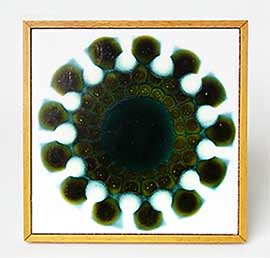
Alan Wallwork Briglin tile

Alan Wallwork Briglin tile
See also:
Alan Wallwork Briglin tile - 6" (152 mm) square.
The size excludes the wooden frame. This item has four rubber feet glued to backing, so would have been sold as a teapot stand.Wallwork, Alan
Alan Wallwork was born in Watford, Hertfordshire in 1931. He studied pottery at Newlands Park Teachers' Training College in Buckinghamshire and won eligibility for a one-year course at Goldsmith's College and studied pottery under Kenneth Clark and Gordon Baldwin whose attitudes influenced him. Upon leaving Goldsmith's he spent some time teaching at local schools.
In 1958 he opened his first studio and gallery in Forest Hill, South London, sharing with ex-students from Goldsmith's. The gallery, named The Alan Gallery, sold both ceramics and paintings. It was soon evident that the ceramics were out-selling the pictorial work. Alan was making domestic wares and hand-built pieces. He experimented with tin-glazing, brush and sgraffito decoration, rubbed-on oxides. Textures were created by incising, rouletting and stamping often inlaid with white slip. It was at this time that he started making tiles which proved popular and led to the phasing out of domestic wares. At around this time Bernard Rooke, also ex-Goldsmith's, joined Alan to share the working and living accommodation; they held common views about ceramic design.
It was soon clear that they had outgrown the Forest Hill premises, which were designated as retail, and they moved to much larger premises in Greenwich which were shared with other artists including Robert and Sheila Fournier. Work produced here sold successfully and Alan's designs were accepted by the Design Centre and his work found outlets through Heal's department store and the Craft Potters Association, of which he was elected a council member. The association with Heal's led to Alan's work being exhibited in Copenhagen. A very large order for tiles from an advertising agency led to Alan's next move.
It was necessary to take on larger premises to produce these tiles so Alan bought a building previously uses as a chapel in Marnhull, Dorset. For a while he commuted between the two addresses, but this was impractical and before long he decided to stay permanently in Dorset and let the Greenwich premises out to other potters. A gas kiln was installed to complement the existing electric kilns and tile production flourished in the new premises. Heal's and the CPA remained as retails outlets and also the showrooms of Briglin Pottery. Alan occupied these premises for many years concentrating on tiles, hand-built, slabbed, coiled and altered pots and sculptural pieces in reduced stoneware.
Following the economic downturn of the late 1970s he moved to Lyme Regis, also in Dorset, where he made 'organic' pieces. He made another move to nearby Higher Rocombe a few years later where he carried on in the same vein making his pebble and seed-pod forms.
Following illness in the late 1990s Alan's work rate decreased and in 2004 he opened a workshop in Missegre, near Limoux in France where he continues to pot, sending work back to the United Kingdom for exhibition. He no longer makes large forms, settling for small and medium pieces. His work is sold through such places as Walford Craft Centre, The Devon Guild and John Rastall's Harlequin Gallery.
Briglin Pottery
Briglin Pottery was set up in 1948 by Brigitte Goldschmidt and Eileen Lewenstein in Crawford Street, in London's fashionable W1 area.
Their object was to produce well designed, attractive pots that could be used in the home, and to sell them at affordable prices. Although this concept did not fit well with their chosen address, and despite their style being quite different to that in vogue at the time, the venture was successful. The white-glazed earthenware pots with painted decoration were, as specified, appealing, functional and reasonably priced.
Donald Mills, at whose pottery the ladies met, worked with them for the first four years. In 1950, when she married, Brigitte's surname became Appleby - the name she is remembered by. Eileen left Briglin in 1959 to set up her own studio.
Both women were active in the forming of the Craft Potters Association and served it for many years.
The mark is the word 'BRIGLIN' sometimes in a circular 'Hand made in England'. The painted initials 'AB' indicate that a piece is decorated by Anthony Barson.
The pottery closed in 1990. Brigitte Appleby died in April, 2000 and Eileen Lewenstein in March, 2005.
You can visit a web site dedicated to Briglin at www.briglin.com.
| Further Reading: | Briglin Pottery 1948-1990 by Anthea Arnold |


